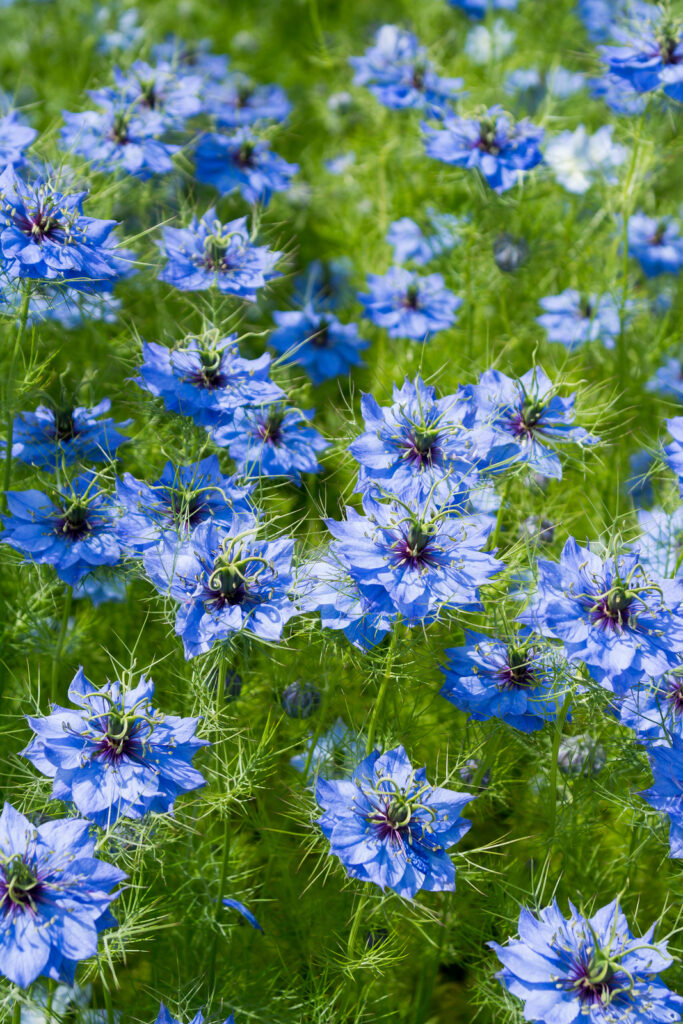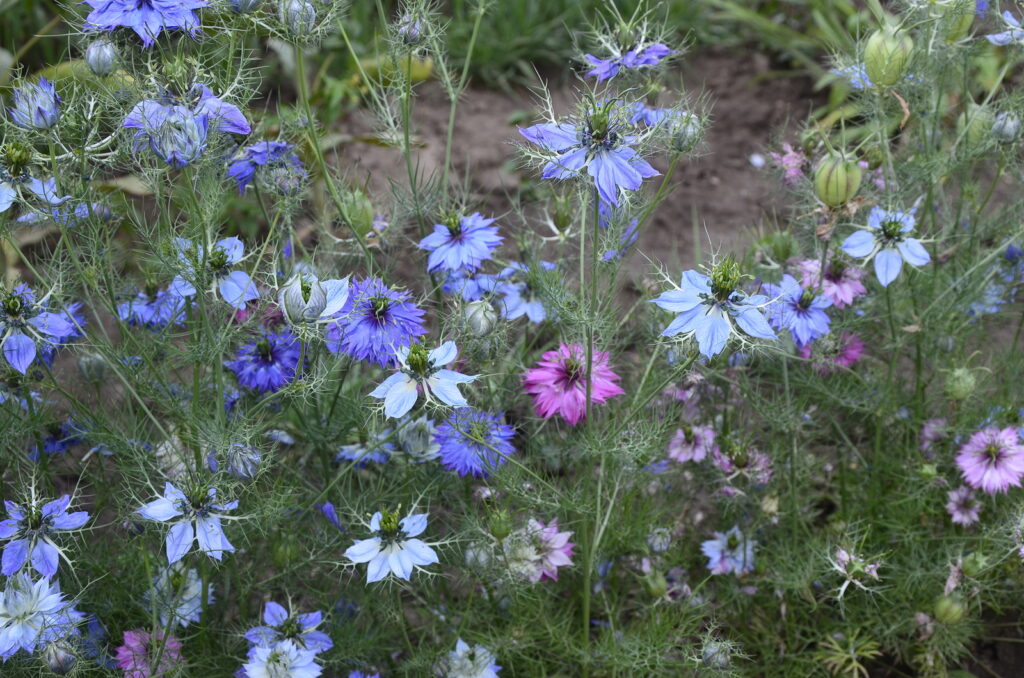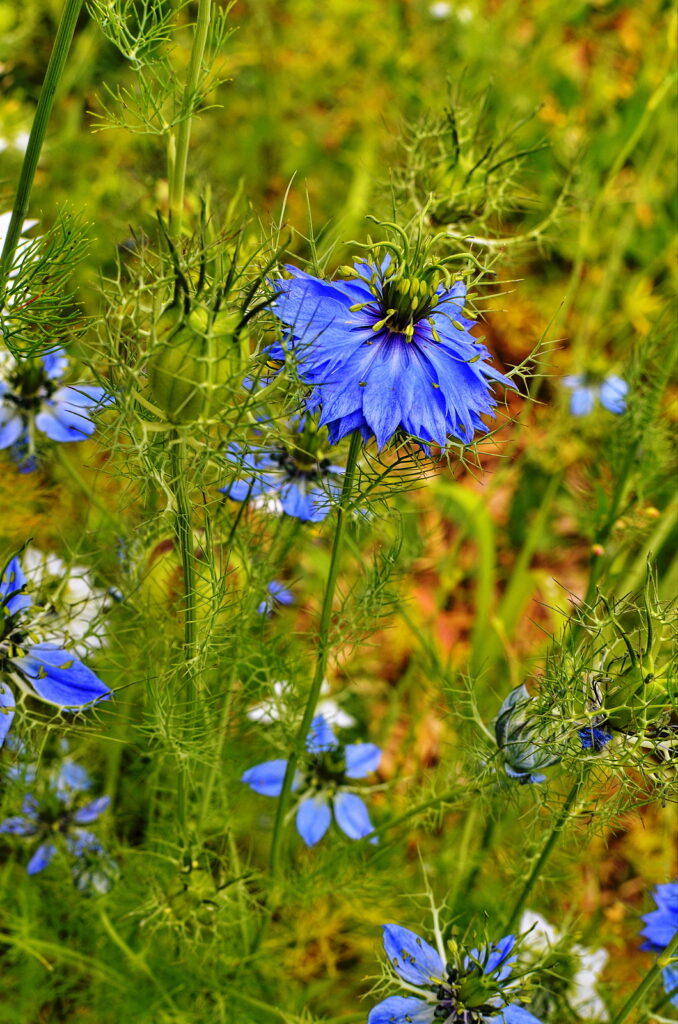Nigella–commonly called love-in-a-mist–is a ferny-leaved annual that produces light blue flowers surrounded by delicate, finely-divided leaflike bracts. Each flower becomes a balloon-like green seedpod that is striped with purple or bronze.
Nigella is a member of the buttercup family. Flowers appear in warm weather. In mild-winter regions, Nigella blooms in late winter and spring. The flowers and seedpods are often used in flower arrangements.
Good Products for Garden Care at Amazon:
- Garden Safe Snail and Slug Bait
- Bonide Sulfur Fungicide
- Monterey BT Caterpillar Killer
- Neem Bliss 100-% Cold Pressed Neem Oil
- Safer Brand Insect Killing Soap
- PyGanic Botanical Insecticide
The Nigella genus consists of 20 species of stiffly erect, bushy annuals. Nigella is native to rocky slopes and fallow fields in the Mediterranean, Eurasia, and North Africa.

Get to Know Nigella
- Plant type: Annual
- Growing Zones and range: All zones
- Hardiness: Killed by heavy frost, thrives in moderate to hot weather
- Height and width: 15 to 24 inches (20-61cm) tall, 6 to 8 inches (15-20cm) wide
- Foliage: Leaves are fine and feathery and alternate
- Flowers: Flat single or double flowers to 1.5 inches (3cm) wide surrounded by feathery bracts followed by puffy seedpods
- Flower colors: Pastel shades of blue, purple, pink, rose, and white
- Bloom time: Any time in warm weather; winter to spring in Zones 10-11
- Uses: Flower arrangements, cottage garden, meadow garden, mixed borders
- Garden companions: spring-blooming bulbs, forget-me-nots
- Common name: Love-in-a-Mist
- Botanical name: Nigella damascena
- Family: Ranunculaceae
- Origin: Fallow fields in the Mediterranean, Eurasia, and North Africa.
Where to Plant Nigella
- Plant Nigella in full sun to light shade; light shade is best in hot summer regions.
- Grow Nigella in average to sandy or gravelly soil with excellent drainage.
- Nigella prefers a soil pH of 6.6-7.5.
Nigella Uses
- Grow Nigella in informal, mixed, or annual borders.
- Nigella is a colorful companion to warm-colored dianthus or to poppies.

When to Plant Nigella
- In Zones 2-7 sow seeds outdoors in early spring a few weeks before the last frost. In Zones 8-11 sow seed in late autumn.
- Start seed indoors about 8 weeks before the last frost.
- Sow seed outdoors at the time of the last expected frost or a week to two earlier; sow seed outdoors in winter in Zones 10-11.
- Set seedlings in the garden after all danger of frost has passed; harden off seedlings for a few days before setting them in the garden.
Planting and Spacing Nigella
- Outdoors sow seed in smoothly prepared planting beds; sow seeds 2 inches (5cm) or more apart. Press seed into the soil and cover with 1/8 inch of soil.
- Plant Nigella 6 to 8 inches (15-20cm) apart. Sow seed onto prepared soil and plant in clusters of 10 or more plants for best effect.
- Thin seedlings from 8 to 12 inches (20-30cm) apart.

How to Water and Feed Nigella
- Nigella needs moderate water; keep the soil evenly moist.
- Mulch plants in dry weather with aged compost or chopped leaves.
- Feed Nigella lightly during the growing season with an all-purpose fertilizer.
Nigella Care
- Nigella self-sows prolifically; plants return year after year.
- Nigella may need support.
- Trim spent blooms to prolong blooming; deadheading may reduce reseeding.
Nigella Propagation
- Sow seed in the garden in mid-spring or autumn; provide protection for autumn-grown plants.
- Sow seed indoors in individual pots or 2 inches (5cm) apart in flats filled with moist potting soil.
- Barely cover the tiny weed with soil; seeds will germinate in about 7 days at 75°F (24°C); after seedlings emerge reduce the temperatures to 60° to 70°F (15.6-21°C).
- Start seeds under a fluorescent light indoors.
- Pot-up seedlings when they have four to six leaves.
Nigella Varieties to Grow
- Nigella damascena is surrouned by thread-like bracts. Cultivars include ‘Persian Jewels’ is a common variety; it’s a mix of blue, deep pink, and white flowers.
- Nigella hispanica is grown for its large, dark, or medium blue single flowers with red stigmata.
- Nigella sativa, also called fennel flower, has blue flowers; the small black seeds can be used as a seasoning.
Nigella Frequently Asked Questions
Q: Why is Nigella called love-in-a-mist?
A: The pink, white, blue, or purple flowers of love-in-a-mist bloom within misty, delicate foliage.
Q: Can I start Nigella indoors?
A: Nigella does not like being transplanted. Sow seeds in individual pots if you start seeds indoors. That will mean less root disturbance at transplant time.
Q: What conditions does Nigella want in the garden?
A: Nigella likes to be started from seed directly in the garden. Sow seeds in the fall for spring bloom. The plant likes full sun, humus-rich moist soil, and cool temperatures.
Related Articles:
- 20 Perennials That Bloom for 6 to 8 Weeks
- Shrubs with Showy Flowers Season-by-Season
- Trees in Garden Design
- Growing Annuals for Summer Bloom
- Trees—click here for more articles
- Shrubs—click here for more articles
- Perennials—click here to see more
- Annuals—click here to see more















